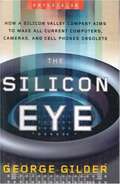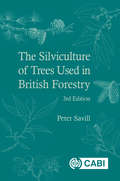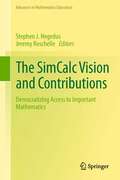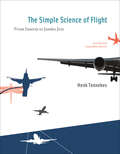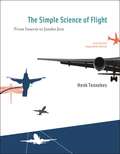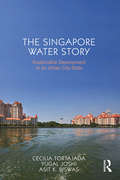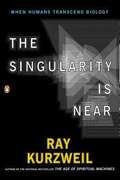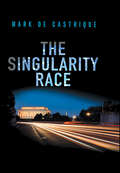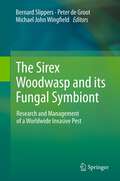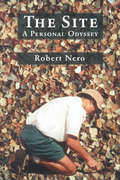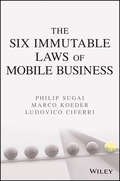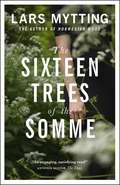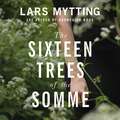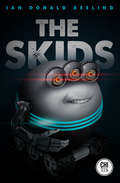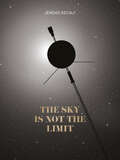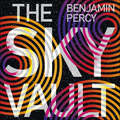- Table View
- List View
The Silicon Eye: How A Silicon Valley Company Aims to Make All Current Computers, Cameras and Cell Phones Obsolete
by George GilderThe Silicon Eye is a narrative of some of the smartest - and most colorful - people on earth and their race to transform an entire industry.
The Silviculture of Trees Used in British Forestry
by Peter SavillBritish woodlands and forests are often located on sites and in regions that are marginal for agriculture; many are at high elevations and exposed, with short growing seasons. Wherever forests are located, site and climatic conditions must dictate species choice in forest management. This book provides a detailed guide to the biological suitability of different sites and soils for all important native trees and the most extensively used exotics. Apart from physical difficulties such as steepness and stoniness, forest soils also frequently have problems associated with them. They can be waterlogged or drought-prone, suffer from extremes of acidity or alkalinity, or have compacted layers. The book provides information on species' suitability for different purposes. It includes details of species' origin and introduction (where applicable), as well as their climatic and soil requirements and other silvicultural characteristics. Information about provenance, yield and timber is also provided. Fully updated throughout, this 3rd edition puts more emphasis on species suitable for changing climatic conditions, with accounts of several species that may become more prominent in British forests: including several silver firs, hickories, eucalypts, spruces, poplars and wingnuts. The book concludes with simple keys for identifying the trees most likely to be encountered in British forests. It is an essential resource for students, researchers and forestry professionals.
The Silviculture of Trees Used in British Forestry
by Peter SavillThe Silviculture of Trees Used in British Forestry, 3rd Edition offers an updated overview of some 68 species of silvicultural importance in British forestry. The book aims to provide concise but detailed information about the silvicultural characteristics of forest trees in Britain, in a readily accessible form. It is written by an internationally recognized expert in silviculture and includes a comprehensive key for identifying common species. For this new edition content has been expanded to cover species susceptible to climate change threats including walnut, eucalypts, sweet chestnut, maples and cherry. It is essential reading for forestry students and practitioners and for forest ecologists and conservation scientists.
The SimCalc Vision and Contributions
by Jeremy Roschelle Stephen J. HegedusThis volume provides essential guidance for transforming mathematics learning in schools through the use of innovative technology, pedagogy, and curriculum. It presents clear, rigorous evidence of the impact technology can have in improving students learning of important yet complex mathematical concepts -- and goes beyond a focus on technology alone to clearly explain how teacher professional development, pedagogy, curriculum, and student participation and identity each play an essential role in transforming mathematics classrooms with technology. Further, evidence of effectiveness is complemented by insightful case studies of how key factors lead to enhancing learning, including the contributions of design research, classroom discourse, and meaningful assessment. The volume organizes over 15 years of sustained research by multiple investigators in different states and countries who together developed an approach called "SimCalc" that radically transforms how Algebra and Calculus are taught. The SimCalc program engages students around simulated motions, such as races on a soccer field, and builds understanding using visual representations such as graphs, and familiar representations such as stories to help students to develop meaning for more abstract mathematical symbols. Further, the SimCalc program leverages classroom wireless networks to increase participation by all students in doing, talking about, and reflecting on mathematics. Unlike many technology programs, SimCalc research shows the benefits of balanced attention to curriculum, pedagogy, teacher professional development, assessment and technology -- and has proven effectiveness results at the scale of hundreds of schools and classrooms. Combining the findings of multiple investigators in one accessible volume reveals the depth and breadth of the research program, and engages readers interested in: * Engaging students in deeply learning the important concepts in mathematics * Designing innovative curriculum, software, and professional development · Effective uses of technology to improve mathematics education * Creating integrated systems of teaching that transform mathematics classrooms * Scaling up new pedagogies to hundreds of schools and classrooms * Conducting research that really matters for the future of mathematics learning * Engaging students in deeply learning the important concepts in mathematics * Designing innovative curriculum, software, and professional development · Effective uses of technology to improve mathematics education * Creating integrated systems of teaching that transform mathematics classrooms * Scaling up new pedagogies to hundreds of schools and classrooms * Conducting research that really matters for the future of mathematics learning
The Simple Art of SoC Design
by Michael Keating, Synopsys FellowThis book tackles head-on the challenges of digital design in the era of billion-transistor SoCs. It discusses fundamental design concepts in design and coding required to produce robust, functionally correct designs. It also provides specific techniques for measuring and minimizing complexity in RTL code. Finally, it discusses the tradeoff between RTL and high-level (C-based) design and how tools and languages must progress to address the needs of tomorrow's SoC designs.
The Simple Life: The unmissable memoir from one of Britain’s most loved presenters
by Sarah BeenyJoin Sarah Beeny on her journey to live more simply and find her forever home...Throughout her life, Sarah Beeny has been obsessed with the idea of home. From her childhood growing up in a countryside cottage to renovating her very first flat in London to restoring a stately home in Yorkshire, she has never been afraid of the hard work needed to turn a house into a home. Now, in her most recent adventure, Sarah and her family have moved to a former dairy farm in Somerset to build the home of their dreams. In The Simple Life, Sarah will tell the story of her life, sharing tales and experiences in everything including parenting, property, friendships, nature and the environment, all the way through to her recent cancer diagnosis and treatment. Through it all, Sarah tackles challenges and troubles with signature wit and wisdom, discovering life is never as 'simple' as you'd like it to be.
The Simple Science of Flight, revised and expanded edition: From Insects to Jumbo Jets
by Henk TennekesAn investigation into how machines and living creatures fly, and of the similarities between butterflies and Boeings, paper airplanes and plovers.From the smallest gnat to the largest aircraft, all things that fly obey the same aerodynamic principles. In The Simple Science of Flight, Henk Tennekes investigates just how machines and creatures fly: what size wings they need, how much energy is required for their journeys, how they cross deserts and oceans, how they take off, climb, and soar. Fascinated by the similarities between nature and technology, Tennekes offers an introduction to flight that teaches by association. Swans and Boeings differ in numerous ways, but they follow the same aerodynamic principles. Biological evolution and its technical counterpart exhibit exciting parallels. What makes some airplanes successful and others misfits? Why does the Boeing 747 endure but the Concorde now seem a fluke? Tennekes explains the science of flight through comparisons, examples, equations, and anecdotes. The new edition of this popular book has been thoroughly revised and much expanded. Highlights of the new material include a description of the incredible performance of bar-tailed godwits (7,000 miles nonstop from Alaska to New Zealand), an analysis of the convergence of modern jetliners (from both Boeing and Airbus), a discussion of the metabolization of energy featuring Lance Armstrong, a novel treatment of the aerodynamics of drag and trailing vortices, and an emphasis throughout on evolution, in nature and in engineering. Tennekes draws on new evidence on bird migration, new wind-tunnel studies, and data on new airliners. And his analysis of the relative efficiency of planes, trains, and automobiles is newly relevant. (On a cost-per-seat scale, a 747 is more efficient than a passenger car.)
The Simple Science of Flight: From Insects to Jumbo Jets (Revised and Expanded Edition)
by Henk TennekesFrom the smallest gnat to the largest aircraft, all things that fly obey the same aerodynamic principles. In The Simple Science of Flight, Henk Tennekes investigates just how machines and creatures fly: what size wings they need, how much energy is required for their journeys, how they cross deserts and oceans, how they take off, climb, and soar. Fascinated by the similarities between nature and technology, Tennekes offers an introduction to flight that teaches by association. Swans and Boeings differ in numerous ways, but they follow the same aerodynamic principles. Biological evolution and its technical counterpart exhibit exciting parallels. What makes some airplanes successful and others misfits? Why does the Boeing 747 endure but the Concorde now seem a fluke? Tennekes explains the science of flight through comparisons, examples, equations, and anecdotes. The new edition of this popular book has been thoroughly revised and much expanded. Highlights of the new material include a description of the incredible performance of bar-tailed godwits (7,000 miles nonstop from Alaska to New Zealand), an analysis of the convergence of modern jetliners (from both Boeing and Airbus), a discussion of the metabolization of energy featuring Lance Armstrong, a novel treatment of the aerodynamics of drag and trailing vortices, and an emphasis throughout on evolution, in nature and in engineering. Tennekes draws on new evidence on bird migration, new wind-tunnel studies, and data on new airliners. And his analysis of the relative efficiency of planes, trains, and automobiles is newly relevant. (On a cost-per-seat scale, a 747 is more efficient than a passenger car.)
The Singapore Water Story: Sustainable Development in an Urban City State
by Asit K. Biswas Cecilia Tortajada Yugal Kishore JoshiSingapore´s journey during the past 45 years is an outstanding example that, in spite of multiple hardships, pragmatic policies, clear visions, long-term planning, forward-looking strategies and political will, as well as a relentless urge to improve, can result in strong foundations for sustainable development. This book describes the journey of Singapore´s development and the fundamental role that water has had in shaping it. What makes this case so unique is that the quest for self-sufficiency in terms of water availability in a fast-changing urban context has been crucial to the way development policies and agendas have been planned throughout the years. The authors analyse plans, policies, institutions, laws and regulations, water demand and water supply strategies, water quality and water conservation considerations, partnerships and importance of the media. They assess overall how all these issues have evolved in response to the dynamic needs of the city-state. The study of Singapore shows how a dynamic society can address development without losing its focus on the environment. In the city-state, environmental concerns in general, and water concerns in particular, have played a major role in its transformation from a third word to a first world country. How and why this transformation took place is the main focus of this authoritative book.
The Singularity Is Near
by Ray KurzweilFor over three decades, Ray Kurzweil has been one of the most respected and provocative advocates of the role of technology in our future. In his classic The Age of Spiritual Machines, he argued that computers would soon rival the full range of human intelligence at its best. Now he examines the next step in this inexorable evolutionary process: the union of human and machine, in which the knowledge and skills embedded in our brains will be combined with the vastly greater capacity, speed, and knowledge-sharing ability of our creations.
The Singularity Race
by Mark de CastriqueThe Singularity—the looming point of no return when Artificial Intelligence surpasses human cognitive abilities, with consequences no one can foresee, and only a handful of people understand.Rusty Mullins, ex-Secret Service, has never heard of the Singularity. He only knows that after the deadly challenges of his last job for security firm Prime Protection, he swore he'd stop risking his life on assignments. Then his good friend Ted Lewison, head of Prime Protection, asks him back for a routine mission guarding Chinese scientist Dr. Lisa Li and her seven-year-old nephew, Peter, and Mullins agrees.The conference on AI bringing Dr. Li to Washington, DC, is barely under way when a team of assassins storms the room. The carnage is great but Mullins saves Dr. Li and Peter while the attackers kill the two other AI experts, along with Lewison.His widow begs Mullins to uncover the power behind the group claiming credit for the assassinations. Is "Double H" homegrown, or part of a larger international conspiracy? Enter eccentric tech billionaire Robert Brentwood who requests Mullins continue to guard Dr. Li and Peter. Brentwood seeks the Singularity and believes Dr. Li holds the key. Mullins agrees in exchange for running his investigation through Brentwood's extraordinary computer resources.The quest leads him on an unexpected path from Naval Intelligence and the Oval Office to a secret research lab in the North Carolina mountains. No one can be trusted—the race for the Singularity is a global winner-takes-all contest.Yet, terrifyingly, a machine with capacity exceeding human intelligence can outstrip all controls while possessing no moral or ethical brakes. As the AI stakeholders go all out, Mullins must face his own singularity—the point of no return—when not just he but his family and Dr. Li's will become casualties in what amounts to war.
The Singularity is Near: When Humans Transcend Biology
by Ray KurzweilFor over three decades, Ray Kurzweil has been one of the most respected and provocative advocates of the role of technology in our future. In his classic The Age of Spiritual Machines, he argued that computers would soon rival the full range of human intelligence at its best. Now he examines the next step in this inexorable evolutionary process: the union of human and machine, in which the knowledge and skills embedded in our brains will be combined with the vastly greater capacity, speed, and knowledge-sharing ability of our creations.
The Sirex Woodwasp and its Fungal Symbiont:
by Bernard Slippers Peter De Groot Michael John WingfieldThe Sirex woodwasp, Sirex noctilio, is the most important invasive alien insect pest of Pinus plantations in the Southern Hemisphere. It now also threatens pines in North America. This book brings together the worldwide knowledge of researchers from Universities and Government institutions, as well as forest industry practitioners that have worked on the pest. Importantly, it is the first comprehensive treatment of the subject since S. noctilio was discovered outside its native range around 1900. The book covers all aspects of the biology and management of S. noctilio, including aspects of the insects' taxonomy, general life history, host-plant relationships, population dynamics, chemical ecology and symbiosis with the fungus Amylostereum areolatum. The book also contains a comprehensive synthesis of the history and current status of the pest and worldwide efforts to control it, including biological control, silviculture and quarantine.
The Site: A Personal Odyssey
by Robert W. NeroPoetry or potsherds? That’s the surprising dilemma one of Canada’s well-known nature writers confronts in The Site: A Personal Odyssey, a highly personalized account of a lifetime’s involvement as an avocational archaeologist. With deft descriptive powers, Robert Nero leads us gently into this new facet of his amazing spectrum of interests. Not unexpectedly, there even is poetry in his approach to studying prehistoric remains! From childhood through adolescence, to wartime service with the U.S. Army in the Southwest Pacific, from exploring the vast sand dunes of Lake Athabasca to excavating a 3,000-year-old site he discovered west of Winnipeg, Nero allows us to share his enthusiasm and excitement in outdoor adventures. There is always a wonderful immediacy in his narrative, the mark of a gifted writer, whether expressed in prose or poetry.
The Six -- Young Readers Edition: The Untold Story of America's First Women Astronauts
by Loren GrushThe extraordinary true story of America&’s first female astronauts hailed as &“suspenseful, meticulously observed, enlightening&” by Margot Lee Shetterly, #1 New York Times bestselling author of Hidden Figures, now adapted for young readers.Sally Ride may have been the first US woman in space, but did you know there were five other incredible American women who helped blaze the trail for female astronauts by her side? When NASA sent astronauts to the moon in the 1960s and 1970s, the agency excluded women from the corps, arguing that only military test pilots—a group women were also aggressively barred from—had the right stuff. But as the 1980s dawned so did new thinking, and six elite women scientists—Sally Ride, Judith Resnik, Anna Lee Fisher, Kathy Sullivan, Shannon Lucid, and Rhea Seddon—set out to prove they had exactly the right stuff to become the first US women astronauts. In The Six Young Readers Edition, acclaimed journalist Loren Grush shows how these brilliant and courageous women fought to enter STEM fields they were discouraged from pursuing, endured claustrophobic—and often deeply sexist—media attention, underwent rigorous survival training, and prepared for years to take multi-million-dollar equipment into orbit. Told with contributions from nearly all the living participants and now adapted for young readers, this book is an inspiring testament to their struggles, accomplishments, and sacrifices and how they built the tools that made the space program run. It&’s a legacy that lives on to inspire young people today.
The Six Immutable Laws of Mobile Business
by Ludovico Ciferri Philip Sugai Marco KoederValuable lessons from Japan's mobile industry yield 6 Immutable Laws for Mobile Business globallyJapan's mobile customers enjoyed better mobile devices, more content, and the most advanced functionality and services for the last 10+ years. This book helps cut through the many myths and all of the hype surrounding Japan's mobile dominance to identify the most important laws that will guide the success of mobile businesses around the world. Based on detailed market analysis and unprecedented access to the major players and pioneers of the Japanese mobile industry, this publication helps you understand the Six Immutable Laws of Mobile Business. These will help you and your business successfully navigate the challenges that the world's Wireless Revolution brings. From Law #1 through Law #6, authors Philip Sugai, Marco Koeder, and Ludovico Ciferri will help guide you to distinguish mobile myth from mobile fact, micro developments from macro trends, and regional characteristics from universal truths.The book highlights Japan's incredible efforts to offer consumers complex, high-tech devices with enriched services that are nonetheless elegant and easy to use, a quest which the authors have labeled "Simplexity." Based on their interviews and observations, the authors assert that, "Simplexity will be what truly empowers individual users through their mobile devices.Filled with case studies exploring all aspects of the Japanese mobile industry, this unique publication points carriers and content and service providers towards successful business models and practices for today's and tomorrow's mobile Internet.This book is the beginning of the conversation of The Six Immutable Laws of Mobile Business, which is regularly being updated and expanded upon at:www.siximmutablelaws.com
The Sixteen Trees of the Somme
by Lars MyttingA family story of epic scale, by the author of NORWEGIAN WOOD and THE BELL IN THE LAKE."An intricate story about war, family, secrets and,yes, wood ... An engaging, satisfying read" The Times"So cleverly plotted, and it builds up such effortless dramatic momentum as it zeroes in on its conclusion" ScotsmanEdvard grows up on a remote mountain farmstead in Norway with his taciturn grandfather, Sverre. The death of his parents, when he was three years old, has always been shrouded in mystery - he has never been told how or where it took place and has only a distant memory of his mother. But he knows that the fate of his grandfather's brother, Einar, is somehow bound up with this mystery. One day a coffin is delivered for his grandfather long before his death - a meticulous, beautiful piece of craftsmanship. Perhaps Einar is not dead after all. Edvard's desperate quest to unlock the family's tragic secrets takes him on a long journey - from Norway to the Shetlands, and to the battlefields of France - to the discovery of a very unusual inheritance. The Sixteen Trees of the Somme is about the love of wood and finding your own self, a beautifully intricate and moving tale that spans an entire century.A TIMES BESTSELLERMytting's book is as much a romantic historical thriller as it is a book of promise, a page-turner as it is a reflective journey into selfhood, history, life's meaning and individual moral responsibility - Mika Provata-Carlone, BookanistaTranslated from the Norwegian by Paul Russell Garrett
The Sixteen Trees of the Somme
by Lars MyttingA family story of epic scale, by the author of NORWEGIAN WOOD and THE BELL IN THE LAKE.Edvard grows up on a remote mountain farmstead in Norway with his taciturn grandfather, Sverre. The death of his parents, when he was three years old, has always been shrouded in mystery - he has never been told how or where it took place and has only a distant memory of his mother. But he knows that the fate of his grandfather's brother, Einar, is somehow bound up with this mystery. One day a coffin is delivered for his grandfather long before his death - a meticulous, beautiful piece of craftsmanship. Perhaps Einar is not dead after all. Edvard's desperate quest to unlock the family's tragic secrets takes him on a long journey - from Norway to the Shetlands, and to the battlefields of France - to the discovery of a very unusual inheritance. The Sixteen Trees of the Somme is about the love of wood and finding your own self, a beautifully intricate and moving tale that spans an entire century.A TIMES BESTSELLERTranslated from the Norwegian by Paul Russell Garrett(P) 2022 Quercus Editions Ltd
The Skadar/Shkodra Lake Environment (The Handbook of Environmental Chemistry #80)
by Andrey G. Kostianoy Vladimir Pešić Gordan KaramanThis book reviews the unique ecosystem of the Lake Skadar/Shkodra and its basin, and discusses the latest advances made in this region to face the impact of climate change. Divided into 23 chapters, the book gathers leading expertise from various scientific and engineering communities and provides readers with extensive discussions of core issues, including the water and sediment chemistry of Lake Skadar/Shkodra and the metal pollution that is evident in plants, aquatic invertebrates and fish. Readers will discover how a sustainable science-based management approach can be applied to the Lake Skadar/Shkodra region, and will learn about the environment prospects for the region. This book is intended as an essential tool for all scientists interested in the Lake Skadar/Shkodra environment – in particular those investigating the interactions between land and water, between limnology and biota, and between natural and cultural resources.
The Skids (The\skids Trilogy Ser.)
by Ian Donald KeelingAs a video game world faces virtual apocalypse, the Skids stop playing and start fighting for their lives in this award-winning debut young adult novel. They’re called the Skids. They’ve got three eyes, tank treads, and a bucket-full of attitude. They live to play the games, score points, and try to make the next level before getting vaped—all for the notion that someone out there must be watching. Johnny Drop’s the best skid the Skidsphere’s seen in generations, but he won’t get to enjoy it for long. Because his world is about to die. And then Johnny’s going to learn that the universe is larger than he ever dreamed. Part Hunger Games, part Ready Player One, and a bit of The Matrix smashed into the mix, The Skids is the Copper Cylinder Award–winning debut novel in the Skids Trilogy.
The Sky Atlas: The Greatest Maps, Myths and Discoveries of the Universe
by Edward Brooke-HitchingAfter the enormous international success of The Phantom Atlas and The Golden Atlas, Edward Brooke-Hitching's stunning new book unveils some of the most beautiful maps and charts ever created during mankind's quest to map the skies above us. This richly illustrated treasury showcases the finest examples of celestial cartography - a glorious genre of map-making often overlooked by modern map books - as well as medieval manuscripts, masterpiece paintings, ancient star catalogues, antique instruments and other appealing curiosities. This is the sky as it has never been presented before: the realm of stars and planets, but also of gods, devils, weather wizards, flying sailors, medieval aliens, mythological animals and rampaging spirits. The reader is taken on a tour of star-obsessed cultures around the world, learning about Tibetan sky burials, star-covered Inuit dancing coats, Mongolian astral prophets and Sir William Herschel's 1781 discovery of Uranus, the first planet to be found since antiquity. Even stranger are the forgotten stories from European history, like the English belief of the Middle Ages in ships that sailed a sea above the clouds, 16th-century German UFO sightings and the Edwardian aristocrat who mistakenly mapped alien-made canals on the surface of Mars.As the intricacies of our universe are today being revealed with unprecedented clarity, there has never been a better time for a highly readable book as beautiful as the night sky to contextualise the scale of these achievements for the general reader.
The Sky Is Not the Limit
by Jérémie DecalfA poetic odyssey through space with the groundbreaking Voyager 2 probe—past Earth, into deep space and beyond.In 1977, a space probe was built to help human beings learn a little more about outer space. Soon, along with its twin, Voyager 2 slipped through the clouds and left Earth behind. The spacecraft traveled for years through the deep, infinite night. At last Voyager 2 reached its first goal: Jupiter. Then it met the spellbinding sight of Saturn. Then, going further than any previous mission, the probe visited the blue ice giants Uranus and Neptune. Past the boundaries of our solar system, Voyager 2 sails on, carrying a Golden Record for any new friends it makes in interstellar space…This lyrical, atmospheric book introduces young readers to a pioneering NASA spacecraft that has spent over forty-five years observing and exploring our galaxy. With stirring poetry, luminous art, and fascinating back matter, The Sky Is Not the Limit will inspire future scientific innovators and foster a sense of wonder at our universe.
The Sky Road: Book Four: The Fall Revolution Series (Fall Revolution Ser. #4)
by Ken MacLeod'Exciting...Accessible to the average reader as well as the hardcore SF fan. This is a work sure to keep the reader on the edge of her seat.' - Romantic Times Bookclub'For my money, Ken MacLeod is the current champion of the very smartest kind of New Space Opera... every variation on his themes produces something worth re-reading.' - LocusCenturies after its catastrophic Deliverance, humanity is again reaching into space. And one young scholar working in the space ship yard, Clovis colha Gree, could make the difference between success and failure. For his mysterious lover, Merrial, has seduced him into the idea of extrapolating the ship's future from the dark archives of the past.A past in which, centuries before, Myra Godwin faced the end of a different space age - her rockets redundant, her people rebellious, and her borders defenceless against the Sino-Soviet Union. As Myra appealed to the falling empires of the West for help, she found history turning on her own dubious past - and on her present decisions. Decisions which, centuries later, will determine the future of the new space age. Merrial's people, the itinerant computer engineers, know this. And they know that the truth they seek lies within the secret files left by Myra Godwin.Set hundreds of years in the future, THE SKY ROAD is the astonishing story of the dawn of a new space age, from the most exciting British SF author to have emerged in recent years.Books by Ken MacLeod:Fall RevolutionThe Star FractionThe Stone CanalThe Cassini DivisionThe Sky RoadEngines of LightCosmonaut KeepDark LightEngine CityCorporation Wars TrilogyDissidenceInsurgenceEmergenceNovelsThe Human FrontNewton's WakeLearning the WorldThe Execution ChannelThe Restoration GameIntrusionDescent
The Sky Road: Book Four: The Fall Revolution Series (Fall Revolutions #4)
by Ken MacLeod'Exciting...Accessible to the average reader as well as the hardcore SF fan. This is a work sure to keep the reader on the edge of her seat.' - Romantic Times Bookclub'For my money, Ken MacLeod is the current champion of the very smartest kind of New Space Opera... every variation on his themes produces something worth re-reading.' - LocusCenturies after its catastrophic Deliverance, humanity is again reaching into space. And one young scholar working in the space ship yard, Clovis colha Gree, could make the difference between success and failure. For his mysterious lover, Merrial, has seduced him into the idea of extrapolating the ship's future from the dark archives of the past.A past in which, centuries before, Myra Godwin faced the end of a different space age - her rockets redundant, her people rebellious, and her borders defenceless against the Sino-Soviet Union. As Myra appealed to the falling empires of the West for help, she found history turning on her own dubious past - and on her present decisions. Decisions which, centuries later, will determine the future of the new space age. Merrial's people, the itinerant computer engineers, know this. And they know that the truth they seek lies within the secret files left by Myra Godwin.Set hundreds of years in the future, THE SKY ROAD is the astonishing story of the dawn of a new space age, from the most exciting British SF author to have emerged in recent years.Books by Ken MacLeod:Fall RevolutionThe Star FractionThe Stone CanalThe Cassini DivisionThe Sky RoadEngines of LightCosmonaut KeepDark LightEngine CityCorporation Wars TrilogyDissidenceInsurgenceEmergenceNovelsThe Human FrontNewton's WakeLearning the WorldThe Execution ChannelThe Restoration GameIntrusionDescent
The Sky Vault: The Comet Cycle Book 3 (The Comet Cycle #2)
by Benjamin PercyThe third and final book in Percy's innovative and acclaimed Comet Cycle, The Sky Vault follows the aftermath of an airplane that goes missing over Fairbanks, Alaska, in the wake of the comet, and a teenager's search for answers about his father's final moments aboard the flight.The comet, Cain, came from beyond our solar system, its debris containing elements unknown. It brought a powerful new metal to the once-declining Midwest; alien fungus to the forests of the Pacific Northwest; and now, in the isolated region of Fairbanks, Alaska, the skies shift and stretch as an interstellar dust cloud seeds itself in the atmosphere. The National Weather Service dismisses the anomaly. Then, an hour outside of Fairbanks, a plane shudders its way through pulpy, swirling, bruise-shaped clouds, lit with sudden cracks of lightning. The sky opens. And the plane vanishes.Theo Jenson is fifteen years old when his father inexplicably disappears along with the plane, and the month-long search for him ends with a funeral procession and the beginnings of acceptance. Despite the tragedy, Theo's popularity in school skyrockets, while his best friend Wheezy remains on the outskirts of any real social circle. Their friendship will be put to the test when other Fairbanks citizens begin to vanish, sucked up by a funnel cloud that extends like an elephant's trunk, and chased down by a mist that solidifies into the shape of a man.Most comets, it's generally believed, are made of a combination of rock and ice. But the fact that so many of them blink out of existence - seen one day, gone the next - makes some scientists believe they are cored with something known as "mirror matter," another term for the dark matter we know exists in the universe because of its gravitational force. The effects of Cain's dark matter are still not entirely known, but its impact on Earth might be more treacherous, or sublime, than could ever be imagined.(P) 2023 HarperCollins Publishers
